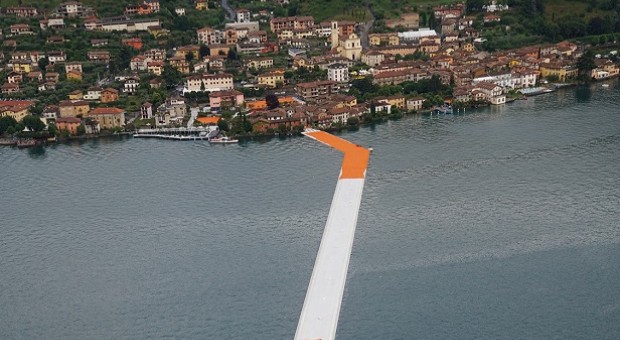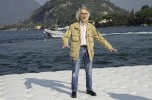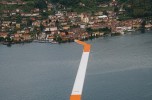Sul Lago d’Iseo The Floating Piers dal 18 giugno al 3 luglio
L’ambiziosa idea non poteva che venire a un artista di nome Christo, del resto far camminare sull’acqua migliaia di persone ogni giorno non è certo alla portata di chiunque.
Se poi il personaggio in questione, oltre ad avere un nome evocativo, è uno dei più coraggiosi esponenti della Land Art al mondo, la cosa si fa subito seria, e quella che può sembrare un’ipotesi incredibile diventa un fatto concreto.
Stiamo parlando di The Floating Piers, l’ultimo lavoro dell’artista bulgaro, visitabile dal 18 giugno al 3 luglio sulle acque del Lago d’Iseo: nelle due settimane con i giorni più lunghi dell’anno il Sebino sarà meta di milioni di turisti, appassionati d’arte, scettici e curiosi, desiderosi di fare un’esperienza che si prospetta indimenticabile.
Sono mesi che sentiamo parlare di questa installazione, ma di che cosa si tratta esattamente?
The Floating Piers significa letteralmente “pontili galleggianti”; nel gergo comune sta diventando famosa come “la passerella di Christo” anche se, ad onor del vero, la sua concezione non è soltanto opera dell’artista ma anche della sua compagna di vita e creazioni, Jeanne-Claude (1935-2011) con la quale aveva progettato questo lavoro nel 1970.
Da allora il pontile è rimasto nel regno delle idee fino alla primavera del 2014 quando Christo, con il direttore Operations Vladimir Yavachev, il Project Manager Wolfgang Volz, Josy Kraft, curatore, e Germano Celant, Project Director dell’opera, hanno esplorato diversi laghi del Nord Italia alla ricerca dell’ispirazione giusta per realizzarlo.
Dopo vari sopralluoghi, il Lago d’Iseo è stato eletto come scenario ideale per l’installazione: la sua conformazione e le isole si prestavano ad accogliere le passerelle, inoltre la corona di montagne circostanti avrebbe permesso di osservare l’installazione anche dall’alto e da diverse angolazioni.
Esattamente un anno dopo, nell’aprile 2015, il progetto è stato messo a punto e annunciato alla stampa.
Detto, fatto. Nei mesi scorsi 200mila cubi di polietilene ad alta densità sono stati accostati per creare un percorso pedonale di 3 chilometri che collega Sulzano a Montisola e all’Isola di San Paolo; i cubi, ricoperti di tessuto giallo cangiante, formano una struttura fluttuante larga 16 metri e a filo d’acqua, per offrire ai visitatori la sensazione di camminare sulle acque.
La formula di quest’opera è quella della Land Art: uno schema minimale che sbalordisce perché esasperato nelle dimensioni e applicato a un vasto contesto ambientale; ciò che viene sperimentato dal fruitore dell’opera è un’esperienza sensoriale, la reinterpretazione di un luogo da una prospettiva spiazzante.
Come tutte le opere di Land Art, uno dei suoi caratteri è la temporaneità: esisterà soltanto per 16 giorni e sarà poi smontata (tutte le componenti verranno dismesse attraverso un processo industriale di riciclaggio) per restituire al Lago la sua vita quotidiana fatta di battelli, piccole imbarcazioni, bagnanti, anatre e cigni.
Ne rimarrà testimonianza in fotografie, video, racconti e nella memoria di chi avrà sperimentato questa esperienza unica.
Per maggiori informazioni: www.thefloatingpiers.com
Livia Salvi
The Floating Piers Istruzioni per l’uso
La passerella sarà percorribile dal 18 giugno al 3 luglio 24 ore su 24 con accesso gratuito, non prenotabile e regolato da un conta-persone. La struttura è omologata per ospitare al massimo 17mila visitatori in contemporanea: sembrano tanti, ma nel weekend e negli orari di punta si prevedono lunghe code quindi armatevi di pazienza, cappelli, ventagli e acqua fresca.
Il percorso sarà praticabile soltanto a piedi (vietate le scarpe con il tacco); passeggini e carrozzine per disabili sono ammessi, mentre non si possono usare biciclette, skateboard e pattini. Non ci sono barriere protettive (è severamente vietato tuffarsi) e la sicurezza è monitorata dal personale presente ogni 50 e 100 metri. In caso di maltempo o vento forte l’installazione verrà chiusa.
Le strade per raggiungere Sulzano sono chiuse al traffico (anche a bici, motociclette e pedoni) e si può arrivare al paese solo con i mezzi pubblici o a piedi dall’antica via Valeriana.
• Treno: con Trenord biglietti a prezzo fisso per viaggiatori singoli, famiglie e gruppi. Viaggi anche sulla locomotiva a vapore più antica d’Europa (www.trenord.it)
• Automobile: potenziati i parcheggi e il servizio di bus navette (prenotabili) dai paesi limitrofi; è scaricabile una app per verificare la disponibilità di posti auto (thefloatingpiersparking.com)
• Per i turisti in arrivo all’Aeroporto di Orio al Serio c’è il bus navetta gratuito IseoExpress, prenotazione obbligatoria (www.iseoexpress.it - www.visitbergamo.net)
• Battelli: circolano ma con viabilità modificata (www.floatingpiers.navigazionelagoiseo.it)
Maggiori dettagli sul sito www.iseolake.info
The art of walking on water
From 18 June to 3 July on the Iseo Lake “The Floating Piers”
 The ambitious idea could only come from an artist whose name is Christo, after all making thousands of people walk on water every day is something that not anyone can do. Moreover, if the artist, apart from having an evocative name, is also one of the bravest Land Art exponents in the world, things start getting really serious, and what seems an incredible hypothesis becomes a concrete fact.
The ambitious idea could only come from an artist whose name is Christo, after all making thousands of people walk on water every day is something that not anyone can do. Moreover, if the artist, apart from having an evocative name, is also one of the bravest Land Art exponents in the world, things start getting really serious, and what seems an incredible hypothesis becomes a concrete fact.As the same title says, this installation is composed of “floating piers”; it is also known as “Christo’s walkway” even if, actually, this work was ideated in 1970 together with his life companion and artistic collaborator Jeanne-Claude (1935-2011).
It remained just an idea until the spring of 2014 when Christo, together with the Operations Director Vladimir Yavachev, the Project Manager Wolfgang Volz, Josy Kraft, curator, and Germano Celant, Project Director of the work, explored several lakes in Northern Italy searching for the right inspiration to realise it.
After various inspections the Iseo Lake revealed to be the ideal scenario for the installation; its conformation and its islands were the perfect environment for the walkways, and the mountains crowning the lake would have allowed observing the installation also from above and from different perspectives.
Exactly one year later, in April 2015, the project was ready and announced to the media. In the last months 200 thousand cubes of high-density polyethylene were assembled to create a pedestrian path of 3 kilometres that connects Sulzano to Montisola and to the Island of San Paolo; the cubes, covered with brilliant yellow fabric, form a 16 metre wide structure floating on water, to offer the visitors the sensation to be walking on water.
The formula of this work is that of Land Art: a minimal art installation that astonishes because of its huge dimensions and applied to a large environmental context; the work offers to the viewer a sensory experience, the reinterpretation of a place according to an unusual perspective.
As all the Land Art works, one of its major characteristics is to be temporary, it will be there only for 16 days and then disassembled (all the components will be disposed of through a recycling industrial process) to make the lake return back to its daily life made of ferry-boats, boats, tourists, ducks, and swans. Photos, videos, narrations, and the memories of those who have lived this unique experience, will testify its short period of existence.
For more information: www.thefloatingpiers.com
The Floating Piers: use instructions
The walkway will be practicable from 18 June to 3 July, 24 hours a day with free access, not bookable and regulated by a people counter.
The structure is homologated to host maximum 17 thousand visitors at the same time: they may seem a lot, but at the weekend and during rush hours we expect long queues, therefore you must arm yourselves with patience, hats, fans, and fresh water.
The course will be practicable only on foot (high heel shoes are prohibited); pushchairs and wheelchairs for disabled people are allowed; bicycles, skateboards, and skates are not allowed. There are no protective barriers (diving is strictly prohibited) and safety is monitored every 50 and 100 metres by the personnel present.
The installation will be closed in case of bad weather or strong wind. The structure is reachable from Sulzano, Monte Isola, Peschiera or Sensole. The roads to the town of Sulzano are closed to traffic (also to bicycles, motorcycles, and pedestrians) and you can reach it only by public transportation or on foot from the ancient via Valeriana.
• Train: Trenord tickets at fixed price for single travellers, families and groups. Journeys available also on the oldest European steam locomotive (www.trenord.it/EN)
• Automobile: increased parking areas and shuttle bus service (bookable) from the nearby towns; an app to check the availability of parking spaces can be downloaded
• There is a free IseoExpress shuttle bus for all the tourists arriving at Orio al Serio Airport, booking is required (www.iseoexpress.it - www.visitbergamo.net)
• Ferry-boats: boats operate with modified routes (www.floatingpiers.navigazionelagoiseo.it)
Further details on the www.iseolake.info website
Traduzione in lingua a cura di ViceVersaGroup - Translations & Multilingual services














